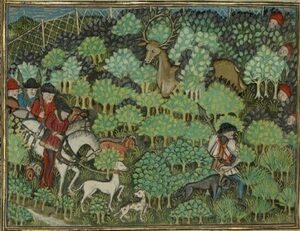From the Medieval Research Blog: "The Stag and the Dogs: A Medieval Fable"

Fables—short moralized narratives, often with animal subjects, associated with the legendary figure of Aesop—have been transmitted and adapted from antiquity down to the present. In the Middle Ages, fables were used to teach Latin to children. One particular fable collection, sometimes called the “elegiac Romulus” for its verse form and supposed dedicatee, seems to have been especially popular in this regard. This collection of approximately 60 fables (many manuscripts have 58 but others may have several more) is extant in almost 200 manuscripts from the thirteenth to sixteenth centuries. Some of these manuscripts show signs of use in the classroom (i.e., they have features such as glosses, words numbered to aid in parsing, etc. An edition by Aaron E. Wright reproduces one such manuscript). There is a critical text of the elegiac Romulus edited by Paola Busdraghi, with a translation into Italian. I offer below my own English translation of one fable from the elegiac Romulus, along with brief commentary.
The fable of The Stag and the Dogs (De cervo et canibus), 74 in the Perry Index, is also known as The Stag at the Spring (Cervus ad fontem) or The Stag and His Antlers (De cervo et cornibus eius). Other medieval versions of this fable are found in prose and verse Latin fable collections in the Romulus tradition; the Parabolae of Odo of Cheriton;[6] the Novus Aesopus of Alexander Neckam; and the Fables of Marie de France.
In this fable, a stag views his own reflection in the spring he drinks at, proud of his many-tined antlers, but critical of his legs, which seem to him too slender. The stag flees as hunting dogs approach, now appreciating the swiftness of his legs, but his antlers become entangled as he passes through dense vegetation, and he is caught and killed. The moral typically advises that we should value or disdain things according to whether they help us or harm us.
This is an excerpt from "The Stag and the Dogs: A Medieval Fable" by Dr. Emily Mahan. Read the full story.